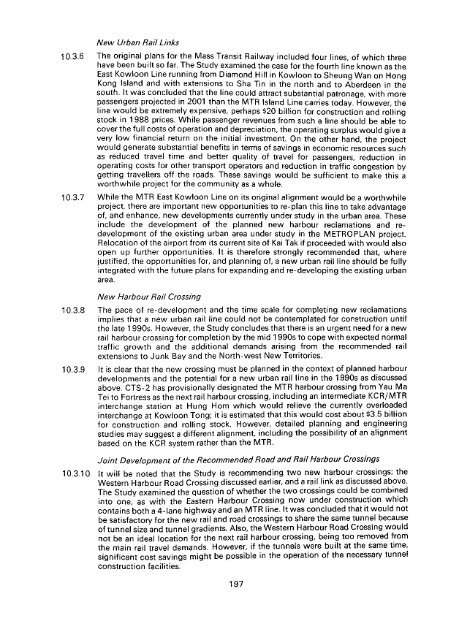Untitled - HKU Libraries - The University of Hong Kong
Untitled - HKU Libraries - The University of Hong Kong
Untitled - HKU Libraries - The University of Hong Kong
- No tags were found...
You also want an ePaper? Increase the reach of your titles
YUMPU automatically turns print PDFs into web optimized ePapers that Google loves.
New Urban Rail Links10.3.6 <strong>The</strong> original plans for the Mass Transit Railway included four lines, <strong>of</strong> which threehave been built so far. <strong>The</strong> Study examined the case for the fourth line known as theEast Kowloon Line running from Diamond Hill in Kowloon to Sheung Wan on <strong>Hong</strong><strong>Kong</strong> Island and with extensions to Sha Tin in the north and to Aberdeen in thesouth, it was concluded that the line could attract substantial patronage, with morepassengers projected in 2001 than the MTR Island Line carries today. However, theline would be extremely expensive, perhaps $20 billion for construction and rollingstock in 1988 prices. While passenger revenues from such a line should be able tocover the full costs <strong>of</strong> operation and depreciation, the operating surplus would give avery low financial return on the initial investment. On the other hand, the projectwould generate substantial benefits in terms <strong>of</strong> savings in economic resources suchas reduced travel time and better quality <strong>of</strong> travel for passengers, reduction inoperating costs for other transport operators and reduction in traffic congestion bygetting travellers <strong>of</strong>f the roads. <strong>The</strong>se savings would be sufficient to make this aworthwhile project for the community as a whole.10.3.7 While the MTR East Kowloon Line on its original alignment would be a worthwhileproject, there are important new opportunities to re-plan this line to take advantage<strong>of</strong>, and enhance, new developments currently under study in the urban area. <strong>The</strong>seinclude the development <strong>of</strong> the planned new harbour reclamations and redevelopment<strong>of</strong> the existing urban area under study in the METROPLAN project.Relocation <strong>of</strong> the airport from its current site <strong>of</strong> Kai Tak if proceeded with would alsoopen up further opportunities. It is therefore strongly recommended that wherejustified, the opportunities for, and planning <strong>of</strong>, a new urban rail line should be fullyintegrated with the future plans for expanding and re-developing the existing urbanarea.New Harbour Rail Crossing10.3.8 <strong>The</strong> pace <strong>of</strong> re-development and the time scale for completing new reclamationsimplies that a new urban rail line could not be contemplated for construction untilthe late 1990s, However, the Study concludes that there is an urgent need for a newrail harbour crossing for completion by the mid 1 990s to cope with expected normaltraffic growth and the additional demands arising from the recommended railextensions to Junk Bay and the North-west New Territories.10.3.9 It is clear that the new crossing must be planned in the context <strong>of</strong> planned harbourdevelopments and the potential for a new urban rail line in the 1990s as discussedabove. CTS-2 has provisionally designated the MTR harbour crossing from Yau MaTei to Fortress as the next rail harbour crossing, including an intermediate KCR/MTRinterchange station at Hung Horn which would relieve the currently overloadedinterchange at Kowloon Tong; it is estimated that this would cost about $3.5 billionfor construction and rolling stock. However, detailed planning and engineeringstudies may suggest a different alignment including the possibility <strong>of</strong> an alignmentbased on the KCR system rather than the MTR.Joint Development <strong>of</strong> the Recommended Road and Rail Harbour Crossings10.3.10 It will be noted that the Study is recommending two new harbour crossings: theWestern Harbour Road Crossing discussed earlier, and a rail link as discussed above.<strong>The</strong> Study examined the question <strong>of</strong> whether the two crossings could be combinedinto one, as with the Eastern Harbour Crossing now under construction whichcontains both a 4-lane highway and an MTR line. It was concluded that it would notbe satisfactory for the new rail and road crossings to share the same tunnel because<strong>of</strong> tunnel size and tunnel gradients. Also, the Western Harbour Road Crossing wouldnot be an idea! location for the next rail harbour crossing, being too removed fromthe main rail travel demands. However, if the tunnels were built at the same time,significant cost savings might be possible in the operation <strong>of</strong> the necessary tunnelconstruction facilities.197
















